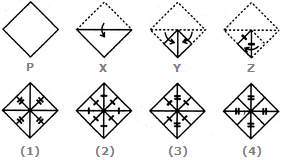Discussion
Home ‣ Non Verbal Reasoning ‣ Cubes and Dice See What Others Are Saying!
- Question
Choose the box that is similar to the box formed from the given sheet of paper (X).

Options- A. 1 and 3 only
- B. 2 and 4 only
- C. 3 and 4 only
- D. 1 and 4 only
- Correct Answer
- 1 and 3 only
ExplanationThe fig. (X) is similar to Form I. So, when the sheet shown in fig. (X) is folded to form a box (cuboid), then the two rectangular-shaded faces lie opposite to each other, two rectangular white faces lie opposite to each other and the two square shaped faces (one shaded and one white) lie opposite to each other. Clearly, the cuboids shown in figures (2) and (4) cannot be formed as in each of the two cuboids the two shaded rectangular faces appear adjacent to each other. So, only the cuboids in figures (1) and (3) can be formed. - 1. Choose the figure which is different from the rest.
 (1) (2) (3) (4) (5)
(1) (2) (3) (4) (5)
Options- A. 1
- B. 2
- C. 3
- D. 4
- E. 5 Discuss
- 2. Two positions of a dice are shown below. When there are two dots at the bottom, the number of dots at the top will be

Options- A. 3
- B. 5
- C. 6
- D. Cannot be determined Discuss
- 3. Identify the figure that completes the pattern.
 (X) (1) (2) (3) (4)
(X) (1) (2) (3) (4)
Options- A. 1
- B. 2
- C. 3
- D. 4 Discuss
- 4. Choose the alternative which is closely resembles the water-image of the given combination.

Options- A. 1
- B. 2
- C. 3
- D. 4 Discuss
- 5. Three different positions X, Y and Z of a dice are shown in the figures given below. Which number lies at the bottom face in position X?

Options- A. 2
- B. 3
- C. 6
- D. Cannot be determined Discuss
- 6. Choose the alternative which is closely resembles the mirror image of the given combination.

Options- A. 1
- B. 2
- C. 3
- D. 4 Discuss
- 7. Choose the figure which is different from the rest.
 (1) (2) (3) (4) (5)
(1) (2) (3) (4) (5)
Options- A. 1
- B. 2
- C. 3
- D. 4
- E. 5 Discuss
- 8. Find out the alternative figure which contains figure (X) as its part.
 (X) (1) (2) (3) (4)
(X) (1) (2) (3) (4)
Options- A. 1
- B. 2
- C. 3
- D. 4 Discuss
- 9. Choose a figure which would most closely resemble the unfolded form of Figure (Z).

Options- A. 1
- B. 2
- C. 3
- D. 4 Discuss
- 10. Choose the figure which is different from the rest.
 (1) (2) (3) (4) (5)
(1) (2) (3) (4) (5)
Options- A. 1
- B. 2
- C. 3
- D. 4
- E. 5 Discuss
More questions
Correct Answer: 3
Explanation:
Only in fig. (3), two out of the four elements are opening in the same direction.
Correct Answer: 3
Explanation:
Number 1 is common to both the positions of the dice. We assume the dice in fig. (ii) to be rotated so that 1 dot moves to the top face (i.e. face V as per activity 1) i.e. to the same position as in fig. (i) and 2 and 4 dots move to the faces hidden behind the faces with 3 and 5 dots respectively. Thus, the combined figure will have 1 dot on the Top (i.e. on face V), 5 dots on Front face (i.e. on face I), 3 dots on RHS face (i.e. face II), 4 dots on the Rear face (i.e. face III) and 2 dots on the LHS face (i.e. face IV). Clearly, 3 dots lie on the face opposite the face having 2 dots. Therefore, when there are 2 dots at the bottom, the number of dots at the top will be 3.
Correct Answer: 1
Explanation:

Correct Answer: 3
Correct Answer: 3
Explanation:
From positions X and Y we conclude that 1, 5, 6 and 3 lie adjacent to 4. Therefore, 2 must lie opposite 4. From positions Y and Z we conclude that 4, 3, 2 and 5 lie adjacent to 6. Therefore, 1 must lie opposite 6. Thus, 2 lies opposite 4, 1 lies opposite 6 and consequently 5 lies opposite 3.
As analysed above, the number on the face opposite 5 is 3. In position X, since 5 lies on the top, therefore 3 must lie at the bottom face.
Correct Answer: 4
Correct Answer: 1
Explanation:
In all other figures, as we move from the innermost to the outermost element, the numbers of sides of the elements either increase or decrease in a sequence.
Correct Answer: 2
Explanation:

Correct Answer: 2
Correct Answer: 5
Explanation:
All others are punctuation marks.
Comments
There are no comments.Programming
Copyright ©CuriousTab. All rights reserved.
